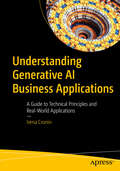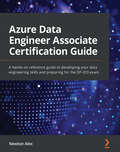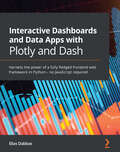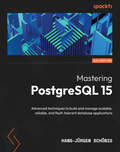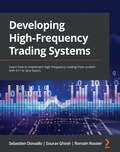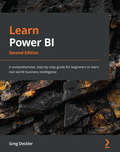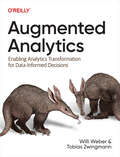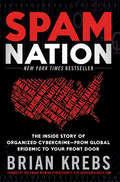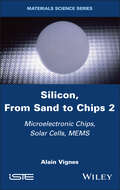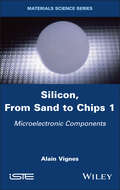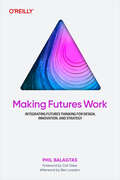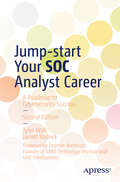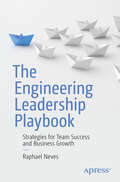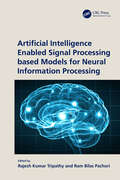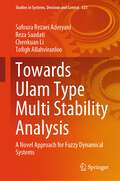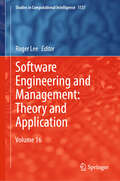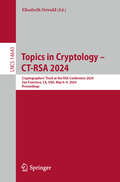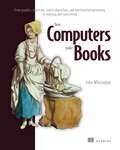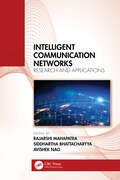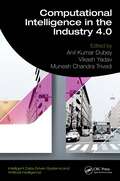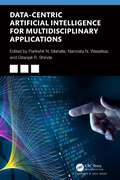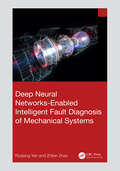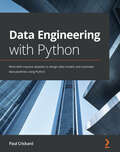- Table View
- List View
Understanding Generative AI Business Applications: A Guide to Technical Principles and Real-World Applications
by Irena CroninThis guide covers the fundamental technical principles and various business applications of Generative AI for planning, developing, and evaluating AI-driven products. It equips you with the knowledge you need to harness the potential of Generative AI for enhancing business creativity and productivity.The book is organized into three sections: text-based, senses-based, and rationale-based. Each section provides an in-depth exploration of the specific methods and applications of Generative AI. In the text-based section, you will find detailed discussions on designing algorithms to automate and enhance written communication, including insights into the technical aspects of transformer-based Natural Language Processing (NLP) and chatbot architecture, such as GPT-4, Claude 2, Google Bard, and others. The senses-based section offers a glimpse into the algorithms and data structures that underpin visual, auditory, and multisensory experiences, including NeRF, 3D Gaussian Splatting,Stable Diffusion, AR and VR technologies, and more. The rationale-based section illuminates the decision-making capabilities of AI, with a focus on machine learning and data analytics techniques that empower applications such as simulation models, agents, and autonomous systems.In summary, this book serves as a guide for those seeking to navigate the dynamic landscape of Generative AI. Whether you’re a seasoned AI professional or a business leader looking to harness the power of creative automation, these pages offer a roadmap to leverage Generative AI for your organization’s success.What You Will LearnWhat are the technical elements that constitute the makeup of Generative AI products?What are the practical applications of Generative AI?How can algorithms be designed to automate and improve written communication?What are the latest Generative AI architectures and algorithms?Who This Book Is ForData scientists, data analysts, decision makers, and business executives interested in gaining an understanding of Generative AI products
Azure Data Engineer Associate Certification Guide: A hands-on reference guide to developing your data engineering skills and preparing for the DP-203 exam
by Newton AlexBecome well-versed with data engineering concepts and exam objectives to achieve Azure Data Engineer Associate certificationKey FeaturesUnderstand and apply data engineering concepts to real-world problems and prepare for the DP-203 certification examExplore the various Azure services for building end-to-end data solutionsGain a solid understanding of building secure and sustainable data solutions using Azure servicesBook DescriptionAzure is one of the leading cloud providers in the world, providing numerous services for data hosting and data processing. Most of the companies today are either cloud-native or are migrating to the cloud much faster than ever. This has led to an explosion of data engineering jobs, with aspiring and experienced data engineers trying to outshine each other.Gaining the DP-203: Azure Data Engineer Associate certification is a sure-fire way of showing future employers that you have what it takes to become an Azure Data Engineer. This book will help you prepare for the DP-203 examination in a structured way, covering all the topics specified in the syllabus with detailed explanations and exam tips. The book starts by covering the fundamentals of Azure, and then takes the example of a hypothetical company and walks you through the various stages of building data engineering solutions. Throughout the chapters, you'll learn about the various Azure components involved in building the data systems and will explore them using a wide range of real-world use cases. Finally, you'll work on sample questions and answers to familiarize yourself with the pattern of the exam.By the end of this Azure book, you'll have gained the confidence you need to pass the DP-203 exam with ease and land your dream job in data engineering.What you will learnGain intermediate-level knowledge of Azure the data infrastructureDesign and implement data lake solutions with batch and stream pipelinesIdentify the partition strategies available in Azure storage technologiesImplement different table geometries in Azure Synapse AnalyticsUse the transformations available in T-SQL, Spark, and Azure Data FactoryUse Azure Databricks or Synapse Spark to process data using NotebooksDesign security using RBAC, ACL, encryption, data masking, and moreMonitor and optimize data pipelines with debugging tipsWho this book is forThis book is for data engineers who want to take the DP-203: Azure Data Engineer Associate exam and are looking to gain in-depth knowledge of the Azure cloud stack.The book will also help engineers and product managers who are new to Azure or interviewing with companies working on Azure technologies, to get hands-on experience of Azure data technologies. A basic understanding of cloud technologies, extract, transform, and load (ETL), and databases will help you get the most out of this book.
Interactive Dashboards and Data Apps with Plotly and Dash: Harness the power of a fully fledged frontend web framework in Python – no JavaScript required
by Elias DabbasBuild web-based, mobile-friendly analytic apps and interactive dashboards with PythonKey FeaturesDevelop data apps and dashboards without any knowledge of JavaScriptMap different types of data such as integers, floats, and dates to bar charts, scatter plots, and moreCreate controls and visual elements with multiple inputs and outputs and add functionality to the app as per your requirementsBook DescriptionPlotly's Dash framework is a life-saver for Python developers who want to develop complete data apps and interactive dashboards without JavaScript, but you'll need to have the right guide to make sure you're getting the most of it. With the help of this book, you'll be able to explore the functionalities of Dash for visualizing data in different ways.Interactive Dashboards and Data Apps with Plotly and Dash will first give you an overview of the Dash ecosystem, its main packages, and the third-party packages crucial for structuring and building different parts of your apps. You'll learn how to create a basic Dash app and add different features to it.Next, you'll integrate controls such as dropdowns, checkboxes, sliders, date pickers, and more in the app and then link them to charts and other outputs. Depending on the data you are visualizing, you'll also add several types of charts, including scatter plots, line plots, bar charts, histograms, and maps, as well as explore the options available for customizing them.By the end of this book, you'll have developed the skills you need to create and deploy an interactive dashboard, handle complexities and code refactoring, and understand the process of improving your application.What you will learnFind out how to run a fully interactive and easy-to-use appConvert your charts to various formats including images and HTML filesUse Plotly Express and the grammar of graphics for easily mapping data to various visual attributesCreate different chart types, such as bar charts, scatter plots, histograms, maps, and moreExpand your app by creating dynamic pages that generate content based on URLsImplement new callbacks to manage charts based on URLs and vice versaWho this book is forThis Plotly Dash book is for data professionals and data analysts who want to gain a better understanding of their data with the help of different visualizations and dashboards – and without having to use JS. Basic knowledge of the Python programming language and HTML will help you to grasp the concepts covered in this book more effectively, but it's not a prerequisite.
Data Quality in the Age of AI: Building a foundation for AI strategy and data culture
by Andrew JonesUnlock the power of data with expert insights to enhance data quality, maximizing the potential of AI, and establishing a data-centric cultureKey FeaturesGain a profound understanding of the interplay between data quality and AIExplore strategies to improve data quality with practical implementation and real-world resultsAcquire the skills to measure and evaluate data quality, empowering data-driven decisionsPurchase of the Kindle book includes a free PDF eBookBook DescriptionAs organizations worldwide seek to revamp their data strategies to leverage AI advancements and benefit from newfound capabilities, data quality emerges as the cornerstone for success. Without high-quality data, even the most advanced AI models falter. Enter Data Quality in the Age of AI, a detailed report that illuminates the crucial role of data quality in shaping effective data strategies. Packed with actionable insights, this report highlights the critical role of data quality in your overall data strategy. It equips teams and organizations with the knowledge and tools to thrive in the evolving AI landscape, serving as a roadmap for harnessing the power of data quality, enabling them to unlock their data's full potential, leading to improved performance, reduced costs, increased revenue, and informed strategic decisions.What you will learnDiscover actionable steps to establish data quality as the foundation of your data cultureEnhance data quality directly at its source with effective strategies and best practicesElevate data quality standards and enhance data literacy within your organizationIdentify and measure data quality within the datasetAdopt a product mindset to address data quality challengesExplore emerging architectural patterns like data mesh and data contractsAssign roles, responsibilities, and incentives for data generatorsGain insights from real-world case studiesWho this book is forThis report is for data leaders and decision-makers, including CTOs, CIOs, CISOs, CPOs, and CEOs responsible for shaping their organization's data strategy to maximize data value, especially those interested in harnessing recent AI advancements.
Mastering PostgreSQL 15: Advanced techniques to build and manage scalable, reliable, and fault-tolerant database applications, 5th Edition
by Hans-Jurgen SchonigMaster the capabilities of PostgreSQL 15 to efficiently administer and maintain your database.Purchase of the print or Kindle book includes a free PDF eBook.Key FeaturesUsing real world examples, get to grips with expert PostgreSQL 15 conceptsExplore performance improvement, database replication, data replication, database administration, and moreExtend PostgreSQL's functionalities to suit your organization's needs with minimal effortBook DescriptionStarting with an introduction to the newly released features of PostgreSQL 15, this updated fifth edition will help you get to grips with PostgreSQL administration and how to build dynamic database solutions for enterprise apps, including designing both physical and technical aspects of the system.You'll explore advanced PostgreSQL features, such as logical replication, database clusters, advanced indexing, and user management to manage and maintain your database. You'll then work with the PostgreSQL optimizer, configure PostgreSQL for high speed, and move from Oracle to PostgreSQL. Among the other skills that the book will help you build, you'll cover transactions, handling recursions, working with JSON and JSONB data, and setting up a Patroni cluster. It will show you how to improve performance with query optimization. You'll also focus on managing network security and work with backups and replication while exploring useful PostgreSQL extensions that optimize the performance of large databases.By the end of this PostgreSQL book, you'll be able to use your database to its utmost capacity by implementing advanced administrative tasks with ease.What you will learnMake use of the indexing features in PostgreSQL and fine-tune the performance of your queriesWork with stored procedures and manage backup and recoveryGet the hang of replication and failover techniquesImprove the security of your database server and handle encryption effectivelyTroubleshoot your PostgreSQL instance for solutions to common and not-so-common problemsPerform database migration from Oracle to PostgreSQL with easeWho this book is forThis database administration book is for PostgreSQL developers, database administrators, and professionals who want to implement advanced functionalities and master complex administrative tasks with PostgreSQL 15. Prior experience in PostgreSQL and familiarity with the basics of database administration will assist with understanding key concepts covered in the book.
Developing High-Frequency Trading Systems: Learn how to implement high-frequency trading from scratch with C++ or Java basics
by Sebastien Donadio Sourav Ghosh Romain RossierUse your programming skills to create and optimize high-frequency trading systems in no time with Java, C++, and PythonKey FeaturesLearn how to build high-frequency trading systems with ultra-low latencyUnderstand the critical components of a trading systemOptimize your systems with high-level programming techniquesBook DescriptionThe world of trading markets is complex, but it can be made easier with technology. Sure, you know how to code, but where do you start? What programming language do you use? How do you solve the problem of latency? This book answers all these questions. It will help you navigate the world of algorithmic trading and show you how to build a high-frequency trading (HFT) system from complex technological components, supported by accurate data.Starting off with an introduction to HFT, exchanges, and the critical components of a trading system, this book quickly moves on to the nitty-gritty of optimizing hardware and your operating system for low-latency trading, such as bypassing the kernel, memory allocation, and the danger of context switching. Monitoring your system's performance is vital, so you'll also focus on logging and statistics. As you move beyond the traditional HFT programming languages, such as C++ and Java, you'll learn how to use Python to achieve high levels of performance. And what book on trading is complete without diving into cryptocurrency? This guide delivers on that front as well, teaching how to perform high-frequency crypto trading with confidence.By the end of this trading book, you'll be ready to take on the markets with HFT systems.What you will learnUnderstand the architecture of high-frequency trading systemsBoost system performance to achieve the lowest possible latencyLeverage the power of Python programming, C++, and Java to build your trading systemsBypass your kernel and optimize your operating systemUse static analysis to improve code developmentUse C++ templates and Java multithreading for ultra-low latencyApply your knowledge to cryptocurrency tradingWho this book is forThis book is for software engineers, quantitative developers or researchers, and DevOps engineers who want to understand the technical side of high-frequency trading systems and the optimizations that are needed to achieve ultra-low latency systems. Prior experience working with C++ and Java will help you grasp the topics covered in this book more easily.
Learn Power BI: A comprehensive, step-by-step guide for beginners to learn real-world business intelligence, 2nd Edition
by Greg DecklerLearn how to use Power BI to deliver the insights needed to help your enterprise survive and thriveKey FeaturesLearn simple through to advanced Power BI features in a clear, concise way using real-world examplesDevelop powerful analytical models and reports that extract key business insightsPublish, share and collaborate on impressive reports, dashboards, apps, and goalsBook DescriptionTo succeed in today's transforming business world, organizations need business intelligence capabilities to make smarter decisions faster than ever before. This updated second edition of Learn Power BI takes you on a journey of data exploration and discovery, using Microsoft Power BI to ingest, cleanse, and organize data in order to unlock key business insights that can then be shared with others. This newly revised and expanded edition of Learn Power BI covers all of the latest features and interface changes and takes you through the fundamentals of business intelligence projects, how to deploy, adopt, and govern Power BI within your organization, and how to leverage your knowledge in the marketplace and broader ecosystem that is Power BI. As you progress, you will learn how to ingest, cleanse, and transform your data into stunning visualizations, reports, and dashboards that speak to business decision-makers. By the end of this Power BI book, you will be fully prepared to be the data analysis hero of your organization – or even start a new career as a business intelligence professional.What you will learnGet up and running quickly with Power BIUnderstand and plan your business intelligence projectsConnect to and transform data using Power QueryCreate data models optimized for analysis and reportingPerform simple and complex DAX calculations to enhance analysisDiscover business insights and create professional reportsCollaborate via Power BI dashboards, apps, goals, and scorecardsDeploy and govern Power BI, including using deployment pipelinesWho this book is forIf you're an IT manager, data analyst, or BI user new to using Power BI for solving business intelligence problems, this book is for you. You'll also find this book helpful if you want to migrate from other BI tools to create powerful and interactive dashboards. No experience of working with Power BI is expected.
Augmented Analytics
by Willi Weber Tobias ZwingmannAugmented Analytics isn't just another book on data and analytics; it's a holistic resource for reimagining the way your entire organization interacts with information to become insight-driven.Moving beyond traditional, limited ways of making sense of data, Augmented Analytics provides a dynamic, actionable strategy for improving your organization's analytical capabilities. With this book, you can infuse your workflows with intelligent automation and modern artificial intelligence, empowering more team members to make better decisions.You'll find more in these pages than just how to add another forecast to your dashboard; you'll discover a complete approach to achieving analytical excellence in your organization.You'll explore:Key elements and building blocks of augmented analytics, including its benefits, potential challenges, and relevance in today's business landscapeBest practices for preparing and implementing augmented analytics in your organization, including analytics roles, workflows, mindsets, tool sets, and skill setsBest practices for data enablement, liberalization, trust, and accessibilityHow to apply a use-case approach to drive business value and use augmented analytics as an enabler, with selected case studies This book provide a clear, actionable path to accelerate your journey to analytical excellence.
Spam Nation: The Inside Story of Organized Cybercrime—from Global Epidemic to Your Front Door
by Brian KrebsA New York Times bestseller and winner of a 2015 Prose Award!There is a threat lurking online. A secret war with the power to destroy your finances, steal your personal data, and endanger your life.In Spam Nation, investigative journalist and cybersecurity expert Brian Krebs unmasks the criminal masterminds driving some of the biggest spam and hacker operations targeting Americans and their bank accounts. Tracing the rise, fall, and alarming resurrection of the digital mafia behind the two largest spam pharmacies—and countless viruses, phishing, and spyware attacks—he delivers the first definitive narrative of the global spam problem and its threat to consumers everywhere.Blending cutting-edge research, investigative reporting, and firsthand interviews, this terrifying true story reveals how we unwittingly invite these digital thieves into our lives every day. From unassuming computer programmers right next door to digital mobsters like "Cosma"—who unleashed a massive malware attack that has stolen thousands of Americans' logins and passwords—Krebs uncovers the shocking lengths to which these people will go to profit from our data and our wallets.Not only are hundreds of thousands of Americans exposing themselves to fraud and dangerously toxic products from rogue online pharmacies, but even those who never open junk messages are at risk. As Krebs notes, spammers can—and do—hack into accounts through these emails, harvest personal information like usernames and passwords, and sell them on the digital black market. The fallout from this global epidemic doesn't just cost consumers and companies billions, it costs lives too.Fast-paced and utterly gripping, Spam Nation ultimately proposes concrete solutions for protecting ourselves online and stemming this tidal wave of cybercrime—before it's too late."Krebs's talent for exposing the weaknesses in online security has earned him respect in the IT business and loathing among cybercriminals… His track record of scoops...has helped him become the rare blogger who supports himself on the strength of his reputation for hard-nosed reporting." —Bloomberg Businessweek
Silicon, From Sand to Chips, Volume 2: Microelectronic Chips, Solar Cells, MEMS
by Alain VignesSilicon is the material of the digital revolution, of solar energy and of digital photography, which has revolutionized both astronomy and medical imaging. It is also the material of microelectromechanical systems (MEMS), indispensable components of smart objects. The discovery of the electronic and optoelectronic properties of germanium and silicon during the Second World War, followed by the invention of the transistor, ushered in the digital age. Although the first transistors were made from germanium, silicon eventually became the preferred material for these technologies. Silicon, From Sand to Chips 2 traces the history of the discoveries, inventions and developments in basic components and chips that these two materials enabled one after the other. The book is divided into two volumes and this second volume is devoted to microelectronic and optoelectronic chips, solar cells and MEMS.
Silicon, From Sand to Chips, Volume 1: Microelectronic Components
by Alain VignesSilicon is the material of the digital revolution, of solar energy and of digital photography, which has revolutionized both astronomy and medical imaging. It is also the material of microelectromechanical systems (MEMS), indispensable components of smart objects. The discovery of the electronic and optoelectronic properties of germanium and silicon during the Second World War, followed by the invention of the transistor, ushered in the digital age. Although the first transistors were made from germanium, silicon eventually became the preferred material for these technologies. Silicon, From Sand to Chips 1 traces the history of the discoveries, inventions and developments in basic components and chips that these two materials enabled one after the other. The book is divided into two volumes and this first volume is devoted to basic microelectronic components.
Fog Computing for Intelligent Cloud IoT Systems (Advances in Learning Analytics for Intelligent Cloud-IoT Systems)
by Ahmed A. Elngar Rajdeep Chakraborty Anupam Ghosh Chandan BanerjeeFOG COMPUTING FOR INTELLIGENT CLOUD IOT SYSTEMS This book is a comprehensive guide on fog computing and how it facilitates computing, storage, and networking services Fog computing is a decentralized computing structure that connects data, devices, and the cloud. It is an extension of cloud computing and is an essential concept in IoT (Internet of Things), as it reduces the burden of processing in cloud computing. It brings intelligence and processing closer to where the data is created and transmitted to other sources. Fog computing has many benefits, such as reduced latency in processing data, better response time that helps the user’s experience, and security and privacy compliance that assures protecting the vital data in the cloud. It also reduces the cost of bandwidth, because the processing is achieved in the cloud, which reduces network bandwidth usage and increases efficiency as user devices share data in the local processing infrastructure rather than the cloud service. Fog computing has various applications across industries, such as agriculture and farming, the healthcare industry, smart cities, education, and entertainment. For example, in the agriculture industry, a very prominent example is the SWAMP project, which stands for Smart Water Management Platform. With fog computing’s help, SWAMP develops a precision-based smart irrigation system concept used in agriculture, minimizing water wastage. This book is divided into three sections. The first section studies fog computing and machine learning, covering fog computing architecture, application perspective, computational offloading in mobile cloud computing, intelligent Cloud-IoT systems, machine learning fundamentals, and data visualization. The second section focuses on applications and analytics, spanning various applications of fog computing, such as in healthcare, Industry 4.0, cancer cell detection systems, smart farming, and precision farming. This section also covers analytics in fog computing using big data and patient monitoring systems, and the emergence of fog computing concerning applications and potentialities in traditional and digital educational systems. Security aspects in fog computing through blockchain and IoT, and fine-grained access through attribute-based encryption for fog computing are also covered. Audience The book will be read by researchers and engineers in computer science, information technology, electronics, and communication specializing in machine learning, deep learning, the cyber world, IoT, and security systems.
Making Futures Work
by Phil BalagtasLearn how to get started with Futures Thinking. With this practical guide, Phil Balagtas, founder of the Design Futures Initiative and the global Speculative Futures network, shows you how designers and futurists have made futures work at companies such as Atari, IBM, Apple, Disney, Autodesk, Lufthansa, and McKinsey & Company.This book demystifies the process of Futures Thinking into a language that's practical and useful for both designers and strategists. You'll learn about Strategic Foresight for using ideas about the future to anticipate and prepare for change; explore Speculative Design to deal with the relationship between science, technology, and humans; and Design Fiction to explore and critique possible futures.Balagtas also shares stories from his journey to build a global community and describes how he works with clients to reshape the futures vocabulary. With this guide, you'll learn how to:Prepare your client, team, and/or audience for futuresFacilitate and work with the fundamental methods and frameworksGain advocacy and support within your organizationProvide measurable value from the process and outcomesBuild a futures culture and teamSustain a culture and support system beyond projects
Jump-start Your SOC Analyst Career: A Roadmap to Cybersecurity Success
by Tyler Wall Jarrett RodrickThe frontlines of cybersecurity operations include many unfilled jobs and exciting career opportunities.A transition to a security operations center (SOC) analyst position could be the start of a new path for you. Learn to actively analyze threats, protect your enterprise from harm, and kick-start your road to cybersecurity success with this one-of-a-kind book. Authors Tyler E. Wall and Jarrett W. Rodrick carefully and expertly share real-world insights and practical tips in Jump-start Your SOC Analyst Career. The lessons revealed equip you for interview preparation, tackling day one on the job, and setting long-term development goals.This book highlights personal stories from five SOC professionals at various career levels with keen advice that is immediately applicable to your own journey. The gems of knowledge shared in this book provide you with a notable advantage for entering this dynamic field of work. The recent surplus in demand for SOC analysts makes Jump-start Your SOC Analyst Career a must-have for aspiring tech professionals and long-time veterans alike. Recent industry developments such as using the cloud and security automation are broken down in concise,understandable ways, to name a few. The rapidly changing world of cybersecurity requires innovation and fresh eyes, and this book is your roadmap to success. New to this edition: This revised edition includes three entirely new chapters: Roadmap to Cybersecurity Success, The SOC Analyst Method, and ChatGPT for SOC Analysts. In addition, new material includes a substantially revised Cloud chapter, revised pre-requisite skills, and minor revisions to all chapters to update data. What You Will Learn • Understand the demand for SOC analysts • Know how to find a SOC analyst job fast • Be aware of the people you will interact with as a SOC analyst • Be clear on the prerequisite skills needed to be a SOC analyst and what to study • Be familiar with the day-to-day life of a SOC analyst, including the tools and language used • Discover the rapidly emerging areas of a SOC analyst job: the cloud • and security automation • Explore the career paths of a SOC analyst • Discover background-specific tips for your roadmap to cybersecurity success • Know how to analyze a security event • Know how to apply ChatGPT as a SOC analyst Who This Book Is For Anyone interested in starting a career in cybersecurity: recent graduates, IT professionals transitioning into security, veterans, and those who are self-taught.
The Engineering Leadership Playbook: Strategies for Team Success and Business Growth
by Raphael NevesIn today's business landscape, software engineering teams must deliver innovation faster than ever. However, outdated management approaches centered on tools and metrics rather than people strangle velocity and creativity. Legacy leaders cling to rigid structures mismatched with market dynamics, draining effort and morale from burnt-out teams. The Engineering Leadership Playbook provides a modern framework to unlock your team's potential through empathy, clarity, and empowerment. Unlike traditional leadership books fixated on delivery metrics, Raphael Neves offers a refreshing people-oriented leadership model tailored to nuances of engineering culture. With 15+ years leading high-growth tech teams, Raphael demystifies how to balance autonomy with alignment, reconstruct feedback models on psychological safety, and sustain excellence amidst uncertainty. You'll learn his proven conflict resolution blueprint for defusing clashes through mutual understanding while tangibly tracking progress. Additionally, his continuous feedback system grounded in evidence spotlights gaps early while accelerating strengths. This playbook moves systematically from foundational concepts like emotional intelligence and leading by example into team development frameworks around high-impact coaching, mentorship, and performance reviews. The method is brought full circle through innovation catalysts that maintain creative momentum at scale. Step-by-step, Raphael unpacks human-centered leadership aligned with accelerating market realities. Apply his engineering management playbook, and your teams will thrive fueled by vision, trust, and care. What You'll Learn Study different leadership styles and how to switch their approaches depending on circumstances Review critical communication skills, especially in technical fields Create IDPs for team members, especially senior engineers and leaders Who This Book Is For Current engineering leaders, aspiring engineering leaders, senior engineers, HR professionals and recruiters, and professionals in related fields
Artificial Intelligence Enabled Signal Processing based Models for Neural Information Processing
by Ram Bilas Pachori Rajesh Kumar TripathyThe book provides details regarding the application of various signal processing and artificial intelligence-based methods for electroencephalography data analysis. It will help readers in understanding the use of electroencephalography signals for different neural information processing and cognitive neuroscience applications. The book: Covers topics related to the application of signal processing and machine learning-based techniques for the analysis and classification of electroencephalography signals Presents automated methods for detection of neurological disorders and other applications such as cognitive task recognition, and brain-computer interface Highlights the latest machine learning and deep learning methods for neural signal processing Discusses mathematical details for the signal processing and machine learning algorithms applied for electroencephalography data analysis Showcases the detection of dementia from electroencephalography signals using signal processing and machine learning-based techniques It is primarily written for senior undergraduates, graduate students, and researchers in the fields of electrical engineering, electronics and communications engineering, and biomedical engineering.
Towards Ulam Type Multi Stability Analysis: A Novel Approach for Fuzzy Dynamical Systems (Studies in Systems, Decision and Control #523)
by Reza Saadati Tofigh Allahviranloo Safoura Rezaei Aderyani Chenkuan LiThe main target of this book is to present a new concept of Ulam-type stability, i.e., multi-stability, through the classical, well-known special functions and to obtain the best approximation error estimates by a different concept of perturbation stability including fuzzy approaches for uncertainty considerations. This stability allows us to obtain diverse approximations depending on various special functions that are initially chosen and to evaluate maximal stability and minimal error which enable us to obtain a unique optimal solution of functional equations, inequalities, and fractional equations. Stability analysis in the sense of the Ulam and its different kinds has received considerable attention from the researchers. However, how to effectively generalize the Ulam stability problems and to evaluate optimized controllability and stability are new issues. The multi-stability not only covers the previous concepts but also considers the optimization of the problem and provides a comprehensive discussion of optimizing the different types of the Ulam stabilities of mathematical models used in the natural sciences and engineering disciplines with fuzzy attitudes. Besides, this book also deals with nonlinear differential equations with various boundary conditions or initial value problems, based on the matrix Mittag-Leffler function, fixed point theory, as well as Babenko's approach to study uniqueness and existence of solutions. In general, the benefits for the readers can be concluded as follows: 1. Evaluates maximal stability with minimal error to get a unique optimal solution. 2. Discusses an optimal method of the alternative to study existence, uniqueness, and different types of Ulam stabilities under special consideration of the fuzzy approaches. 3. Delves into the new study of boundary value problems of fractional integro-differential equations with integral boundary conditions and variable coefficients.
Software Engineering and Management: Volume 16 (Studies in Computational Intelligence #1137)
by Roger LeeThe book reports state of the art results in Software Engineering Research, Management & Applications in both printed and electronic form. SCI (Studies in Computation Intelligence) has grown into the most comprehensive computational intelligence research forum available in the world.This volume published original papers on both theory and practice that address foundations, state of the art problems and solutions, and crucial challenges.
Topics in Cryptology – CT-RSA 2024: Cryptographers’ Track at the RSA Conference 2024, San Francisco, CA, USA, May 6–9, 2024, Proceedings (Lecture Notes in Computer Science #14643)
by Elisabeth OswaldThis book constitutes the refereed proceedings of the Cryptographer's Track at the RSA Conference 2024, CT-RSA 2024, held in San Francisco, CA, USA, during May 6–9, 2024. The 18 full papers presented in this volume were carefully reviewed and selected from 46 submissions. The conference presents papers on subjects such as public key cryptography; symmetric cryptography; signatures; homomorphic encryption; identity-based encryption; constructions; and threshold signatures and fault attacks.
How Computers Make Books: From graphics rendering, search algorithms, and functional programming to indexing and typesetting
by John WhitingtonLearn about computer science by exploring the fascinating journey it took to make this book!How Computers Make Books introduces what&’s wonderful about computer science by showing how computers have transformed the art of publishing books. Author and publishing software developer John Whitington reveals the elegant computer science solutions invented to solve big publishing challenges. In How Computers Make Books you&’ll discover: How human descriptions are translated into computer programs How a computer can understand document formatting How a program decides where to print ink on a page Why computer science is so interesting to computer scientists, and why it might interest you …and much more! How do computers represent all the different languages and letters used by humans? How do we compress a book&’s worth of complex information so it can be transferred in seconds? And what exactly is a computer program? This book answers all those questions by telling the story of how it was created! About the technology Computers are part of every step in creating a book, from capturing the author&’s words as a digital document to controlling how the ink gets onto the paper. How Computers Make Books introduces basic computer science concepts like file formatting, transfer, and storage, computer programming, and task automation by guiding you through the modern digital printing process. About the book This book takes you on a journey from the plain white page, weaving through typesetting, making gray images from black ink, electronic file formats, and more. It makes computer science come alive as you see how every word, illustration, and page has its own story. You&’ll even learn to write your own simple programs and discover hands-on what&’s so intoxicating about computer science. What's inside How human descriptions are translated into computer programs How a digital computer thinks about print documents How a program decides where to print ink on a page How the history of typesetting shows up in modern books About the reader For the curious-but-clueless about computer science—and anyone interested in how computers make books! About the author John Whitington is the founder of a company that builds software for electronic document processing. He has studied and taught Computer Science at Queens&’ College, Cambridge. Technical editor on this book was Bojan Stojanovic. Table of Contents 1 Putting marks on paper 2 Letter forms 3 Storing words 4 Looking and finding 5 Typing it in 6 Saving space 7 The sums behind the screen 8 Gray areas 9 A typeface 10 Words to paragraphs 11 Out into the world
Intelligent Communication Networks: Research and Applications
by Siddhartha Bhattacharyya Avishek Nag Rajarshi MahapatraWith the advent of Big Data, conventional communication networks are often limited in their inability to handle complex and voluminous data and information as far as effective processing, transmission, and reception are concerned. This book discusses the evolution of computational intelligence techniques in handling intelligent communication networks. Provides a detailed theoretical foundation of machine learning and computational intelligence algorithms Highlights the state of art machine learning-based solutions for communication networks Presents video demonstrations and code snippets on each chapter for easy understanding of the concepts Discusses applications including resource allocation, spectrum management, channel estimation, and physical layer of wireless networks Demonstrates applications of machine learning techniques for optical networks The text is primarily intended for senior undergraduate and graduate students and academic researchers in fields of electrical engineering, electronics and communication engineering, and computer engineering.
Computational Intelligence in the Industry 4.0 (Intelligent Data-Driven Systems and Artificial Intelligence)
by Anil Kumar Dubey Vikash Yadav Munesh Chandra TrivediThis book discusses the importance of using industrial intelligence in collaboration with computational intelligence in forming a smart system for diverse applications. It further illustrates the challenges and deployment issues in industrial resolution. The text highlights innovation and applications of computational agents and the industrial intelligence era to automate the requirements as per Industry 4.0.This book: Discusses computational agents for handling automation issues and the role of ethics in industrial resolution Presents intelligence approaches for products, operations, systems, and services Illustrates the fundamentals of computational intelligence to forecast and analyze the requirements of society for automation as well as recent innovations and applications Highlights computation intelligence approaches in reducing human effort and automating the analysis of the production unit Showcases current innovation and applications of computational agents and industrial intelligence as per Industry 4.0 The text is primarily written for senior undergraduate and graduate students, and academic researchers in diverse fields including electrical engineering, electronics, and communication engineering, industrial engineering, manufacturing engineering and computer science, and engineering.
Data-Centric Artificial Intelligence for Multidisciplinary Applications
by Parikshit N. Mahalle Gitanjali R. Shinde Namrata N. WasatkarThis book explores the need for a data‑centric AI approach and its application in the multidisciplinary domain, compared to a model‑centric approach. It examines the methodologies for data‑centric approaches, the use of data‑centric approaches in different domains, the need for edge AI and how it differs from cloud‑based AI. It discusses the new category of AI technology, "data‑centric AI" (DCAI), which focuses on comprehending, utilizing, and reaching conclusions from data. By adding machine learning and big data analytics tools, data‑centric AI modifies this by enabling it to learn from data rather than depending on algorithms. It can therefore make wiser choices and deliver more precise outcomes. Additionally, it has the potential to be significantly more scalable than conventional AI methods.• Includes a collection of case studies with experimentation results to adhere to the practical approaches• Examines challenges in dataset generation, synthetic datasets, analysis, and prediction algorithms in stochastic ways• Discusses methodologies to achieve accurate results by improving the quality of data• Comprises cases in healthcare and agriculture with implementation and impact of quality data in building AI applications
Deep Neural Networks-Enabled Intelligent Fault Diagnosis of Mechanical Systems
by Ruqiang Yan Zhibin ZhaoThe book aims to highlight the potential of deep learning (DL)-enabled methods in intelligent fault diagnosis (IFD), along with their benefits and contributions.The authors first introduce basic applications of DL-enabled IFD, including auto-encoders, deep belief networks, and convolutional neural networks. Advanced topics of DL-enabled IFD are also explored, such as data augmentation, multi-sensor fusion, unsupervised deep transfer learning, neural architecture search, self-supervised learning, and reinforcement learning. Aiming to revolutionize the nature of IFD, Deep Neural Networks-Enabled Intelligent Fault Diangosis of Mechanical Systems contributes to improved efficiency, safety, and reliability of mechanical systems in various industrial domains.The book will appeal to academic researchers, practitioners, and students in the fields of intelligent fault diagnosis, prognostics and health management, and deep learning.
Data Engineering with Python: Work with massive datasets to design data models and automate data pipelines using Python
by Paul CrickardBuild, monitor, and manage real-time data pipelines to create data engineering infrastructure efficiently using open-source Apache projectsKey FeaturesBecome well-versed in data architectures, data preparation, and data optimization skills with the help of practical examplesDesign data models and learn how to extract, transform, and load (ETL) data using PythonSchedule, automate, and monitor complex data pipelines in productionBook DescriptionData engineering provides the foundation for data science and analytics, and forms an important part of all businesses. This book will help you to explore various tools and methods that are used for understanding the data engineering process using Python. The book will show you how to tackle challenges commonly faced in different aspects of data engineering. You’ll start with an introduction to the basics of data engineering, along with the technologies and frameworks required to build data pipelines to work with large datasets. You’ll learn how to transform and clean data and perform analytics to get the most out of your data. As you advance, you'll discover how to work with big data of varying complexity and production databases, and build data pipelines. Using real-world examples, you’ll build architectures on which you’ll learn how to deploy data pipelines. By the end of this Python book, you’ll have gained a clear understanding of data modeling techniques, and will be able to confidently build data engineering pipelines for tracking data, running quality checks, and making necessary changes in production.What you will learnUnderstand how data engineering supports data science workflowsDiscover how to extract data from files and databases and then clean, transform, and enrich itConfigure processors for handling different file formats as well as both relational and NoSQL databasesFind out how to implement a data pipeline and dashboard to visualize resultsUse staging and validation to check data before landing in the warehouseBuild real-time pipelines with staging areas that perform validation and handle failuresGet to grips with deploying pipelines in the production environmentWho this book is forThis book is for data analysts, ETL developers, and anyone looking to get started with or transition to the field of data engineering or refresh their knowledge of data engineering using Python. This book will also be useful for students planning to build a career in data engineering or IT professionals preparing for a transition. No previous knowledge of data engineering is required.
